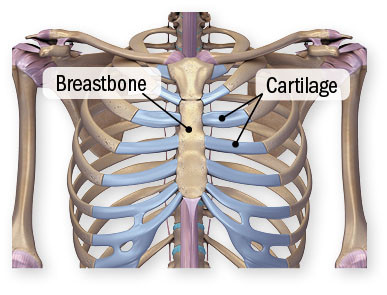Chest pain from inflamed joints
Ask the doctor

Q. My wife was having unusual chest pains and was diagnosed with costochondritis. But it's lasted for weeks now, and I worry that she might have a heart problem. How can doctors be sure it's not her heart?
A. Costochondritis is one of several conditions that are often mistaken for a heart-related problem. (Another is heartburn.) Costochondritis results from inflammation of the tough, flexible connective tissue (cartilage) between the ribs and the breastbone, called the costosternal joints (see illustration).
Possible causes of costochondritis include a blow to the chest, strenuous exercise, or heavy weight lifting. A respiratory or joint infection, severe coughing, and certain types of arthritis may also trigger the condition. But more often than not, the cause is unknown.
The main symptoms are pain and tenderness in the chest. The pain may feel sharp or dull and gnawing and often worsens when a person takes a deep breath, coughs, or lies down. The chest may feel tender and possibly swollen when pressed. Rest and quiet breathing tends to ease the pain somewhat.
In contrast, people often describe heart attacks as uncomfortable squeezing, tightness, or pressure in the center of the chest; other varied symptoms can also occur. Because heart attacks are common and potentially serious, it's the first thing a doctor will rule out if a person shows up in any medical setting with chest pain. The testing includes an electrocardiogram, a brief, painless test that may reveal a distinct signature if a heart attack is occurring (or happened in the past). A blood test that checks for damage to the heart muscle is standard practice; other tests may be done as well.
Doctors always take a medical history, which may have helped pin down your wife's diagnosis. There are no lab or imaging tests to confirm a diagnosis of costochondritis with certainty. The problem usually goes away on its own, without any treatment. But it can last several months and sometimes up to a year. In the meantime, people can take pain medications, such as acetaminophen (Tylenol) or ibuprofen (Advil, Motrin), or apply pain-relieving creams or gels to the affected area. These include over-the-counter creams that contain capsaicin or salicylates, or a 1% diclofenac gel (Voltaren). Exercises that might aggravate the problem, such as rowing or weight lifting, may need to be avoided. Gentle stretching exercises may help; so can putting either a heating pad or ice pack on the painful area a few times a day.
Image: © 7activestudio/Getty Images
About the Author

Deepak L. Bhatt, M.D., M.P.H, Former Editor in Chief, Harvard Heart Letter
Disclaimer:
As a service to our readers, Harvard Health Publishing provides access to our library of archived content. Please note the date of last review or update on all articles.
No content on this site, regardless of date, should ever be used as a substitute for direct medical advice from your doctor or other qualified clinician.
















